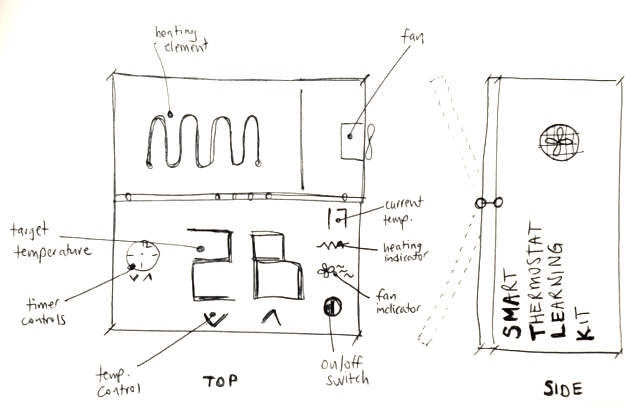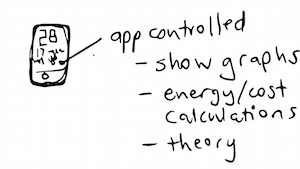Week 1 - final project outline
Assignment tasks for this week
plan and sketch a potential final project
Final project - Smart Thermostat Learning Kit
This page provides a short (initial) description of my final project, but I will keep updated project documentation as I go through the semester on my final project page.
I was quite inspired by Denis Terwagne's 2017 final project which was a physics tinking kit, to provide a cleverly designed platform for students to play with various aspects relating to physics theory.

Fig 1-1 Denis Terwagne's final project (2017).
I teach product design and development, prototyping and CAD/CAE, but one of the areas I want to focus on in the coming years is electronic prototyping, so I would like my final project to be a electronic product design kit that supports students' learning and experimenting as they prototype with electronics. It would also be great to compile some useful resources in this area. My colleague, Dr Jerome Leary has produced a
useful site for digital fabrication tools
If I can also produce something to complement this for our students it would be ideal. I would like to produce some fabacademy style resources for my design project modules (DP401 beautiful project, DP402 durable project, DP403 usable project, DP404 digital fabrication methods, DP504 digital fabrication project).
The main one to focus on will be the DP403 project, and I'd like to develop a SMArt Thermostat LEarning Kit (SMATLEK). This will be a small lunchbox sized control unit that is built up in stages to help students learn the basics of electronics and heat power/energy. From this, they can learn the basics needed to help them design toasters, kettles, bread makers, thermostats, heaters, etc. The basic specification for this is that it should:
1. Connect a small heating device with a power supply and switch to heat up a small thermal mass.
2. Use a potentiometer to control the amount of heat given off.
3. Add a small motorised fan with switch and potentiometer to control cooling of the device.
4. Develop a temperature measuring circuit to indicate when a set temperature is reached.
5. Integrate all the above steps with a relay to control the heater using a thermostat.
6. Add a timing circuit to allow the system to be turned off after a set time.
7. Connect the system to the internet and control using a basic web based input.
8. Develop an app to set the temperature and time of the thermostat.
9. Develop an algorithm to improve the performance of the thermostat and turn it into a 'smart' thermostat. Include graphs, theory, calculators for energy/cost.
I've recently installed a smart thermostat into my house (Tado), and have been really impressed by this. It has really got me thinking about how the algorithm works, but it's also made me realise that I can use this as a learning tool for my students to learn about heat, control, and electronics.



Fig 1-2 My Smart Thermostat Learning Kit - final project idea.
I did consider a number of other projects, but decided on this project since it will help me considerably in one of my key teaching projects, and I think I will learn the most by doing this also.
- a kit to make a lathe for the lab (and to make another one for my mancave at home
- an autonomous vacuum cleaning robot for my home
- a small electric gocart for my daughter